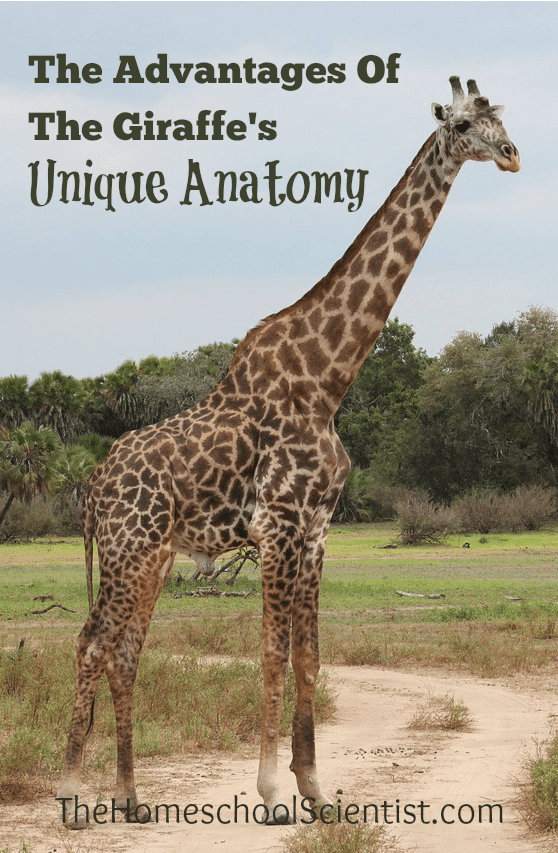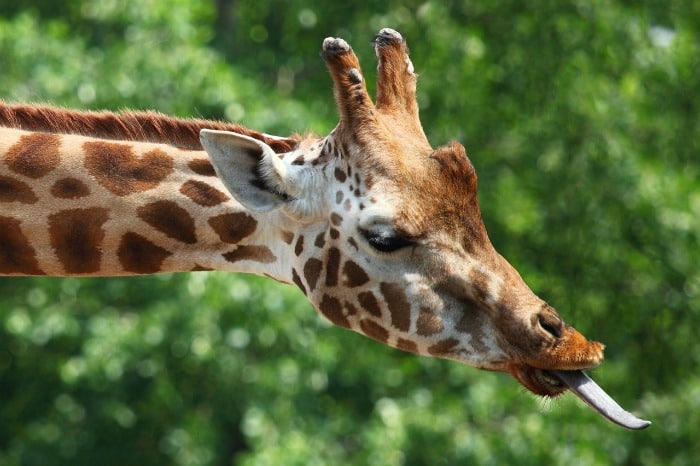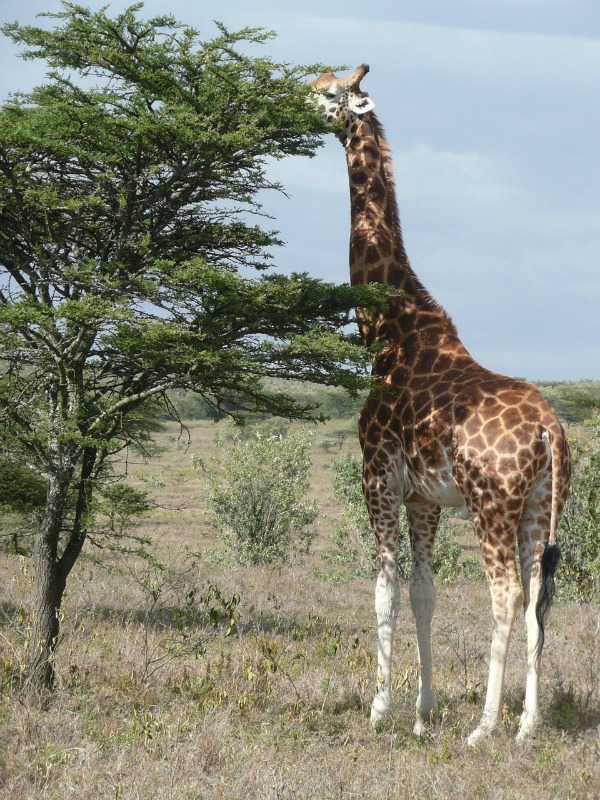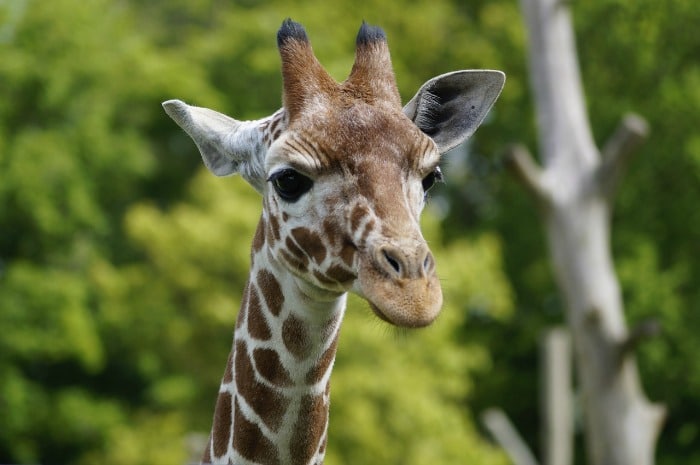The Advantages Of The Giraffe’s Unique Anatomy {Plus A Giraffe Report Printable}

The unusual features of a giraffe’s anatomy make them one of the most recognizable animals in the world. Their long neck, spindly legs, and spots set them apart. A giraffe’s sheer size along with their gentle demeanor and slow movements make giraffes mesmerizing to watch.
In the past, we studied giraffes along with other African animals in our homeschool. We learned the basics of their size, habitat, and habits. One of the things that intrigued us the most was how different the giraffe was from all other animals that it shared a habitat with and how it is the uniqueness of the giraffe anatomy that makes it perfectly suitable to survive along side other animals.
Table of Contents
Giraffe Habitat
Giraffes are social mammals living in herds on the savannas of sub-Saharan Africa. Savannas are grassy plains dotted with trees (usually acacia trees). Giraffes share this habitat with other animals such as zebras, cape buffalo, antelope, lions, cheetahs, and wild dogs.
Giraffe Anatomy – Advantages Of A Giraffe’s Long Legs And Long Neck
When giraffes are born, they are already huge at 6 feet tall and around 150 pounds. Full grown giraffes average 16-18 feet tall. Males can reach 2600 lbs, while females are typically smaller at around 1800 lbs. These are large animals!
The great height of the giraffe can be attributed to their long legs and neck. The legs of adult giraffes along average 6 feet tall. That’s taller than most full-grown human adults! Their legs appear skinny and bony with little muscle. The secret to these twiggy legs’ ability to hold up all the giraffe weight is in their ligaments. Ligaments are connective tissue that hold bones together. Scientist believe that giraffes have special suspensatory ligaments in their legs that are key to the their stability and strength. These are pieces of connective tissue that provide extra stability and strength to help support the weight of the giraffe.
The necks of giraffes are their most recognizable feature. They can grow to 6 feet long and weigh 600 lbs. Although the necks of giraffes are huge, they have 7 cervical, or neck, vertebrae, just like humans. However, each cervical vertebrae of giraffes can be 10 inches long.
The length of the giraffe’s neck gives them advantages when it comes to finding food. Giraffes are herbivores preferring the leaves of acacia trees. They can reach the high leaves of trees that no other animal can reach. This means there is no other competition for this food and other leaves and grasses closer to the ground are left for other animals.
When tree leaves are not available, giraffes can, also because of their long necks, reach grasses closer to the ground. The ability to eat a range of leaves and grasses from a variety of sources gives giraffes the ability to adapt to changes in its environment. This is important as one adult male giraffe can eat 75 pounds of food each day!

Giraffe Anatomy – The Tongue
Another interesting feature of a giraffe’s anatomy is their tongue? Have you ever seen a giraffe tongue? It’s kind of shocking the first time you see this 18 inch, blue tongue spring out of a giraffe’s mouth and wrap its way around a tree branch and remove its leaves. It’s pretty cool actually and serves the giraffe quite well. This long tongue is perfect for the diet of the giraffe.
Giraffes love the leaves of the acacia tree. The problem is that acacia branches are covered in thorns. These sharp thorns would injure the head and mouth of almost all animals who would dare eat the acacia leaves…except for the giraffe. The giraffe’s tongue is long enough to reach and remove the leaves from the acacia branch without allowing the head of the giraffe to get close enough to get injured by the thorns. The tongue is very rough and thick preventing it from getting hurt by the thorns.
Blue? Yes! The tongue of the giraffe is dark blue or purple. Scientist think this is sunscreen for the giraffe. Since giraffes eat constantly with their tongues exposed 12 hours a day, they need protection from the sun. Can you imagine a sunburn on your tongue? Ouch!

Giraffe Anatomy – Their Special Digestive System
Giraffes have a special type of digestive system that is very efficient. Most of what the giraffes eat gets converted into energy. Like cows, giraffes are ruminant animals. This means they have a four chambered stomach. Each chamber plays an important role in breaking down the leaves the giraffe eats.
The first chamber, the rumen, is more of a storage compartment where bacteria start the digestion process. When the food is broken down a bit by the bacteria, the giraffe regurgitates the food back into its mouth were it is chewed again. This regurgitated food is called cud. This is why it appears that giraffes are eating all the time!
After the cud is chewed, the giraffe swallows it and it is moved through the other chambers of the stomach where digestion continues.

Giraffe Anatomy – Do Giraffes Have Horns?
Giraffes do have two horn-like structures on top of their heads called ossicones. These start as cartilage outgrowths but harden over time. The ossicones of female giraffes are often thin and tufted, while the ossicones of the males are usually thicker and bald because of battling other male giraffes.
Giraffe Anatomy And Fact Links
Do you want more information on giraffes? Here are a few links to further your giraffe study.
- Giraffe Conservation Foundation
- GiraffeWorlds.com
- Animal Fact Guide
- If you enjoyed the post about a giraffe’s anatomy, check out our other animal posts, some with free printable lessons.

Giraffe Report Printable
Use this post as a giraffe lesson and then download this FREE giraffe report printable so your students can record what they learned.
You can, also, download the free animal report printable from The Homeschool Scientist.


